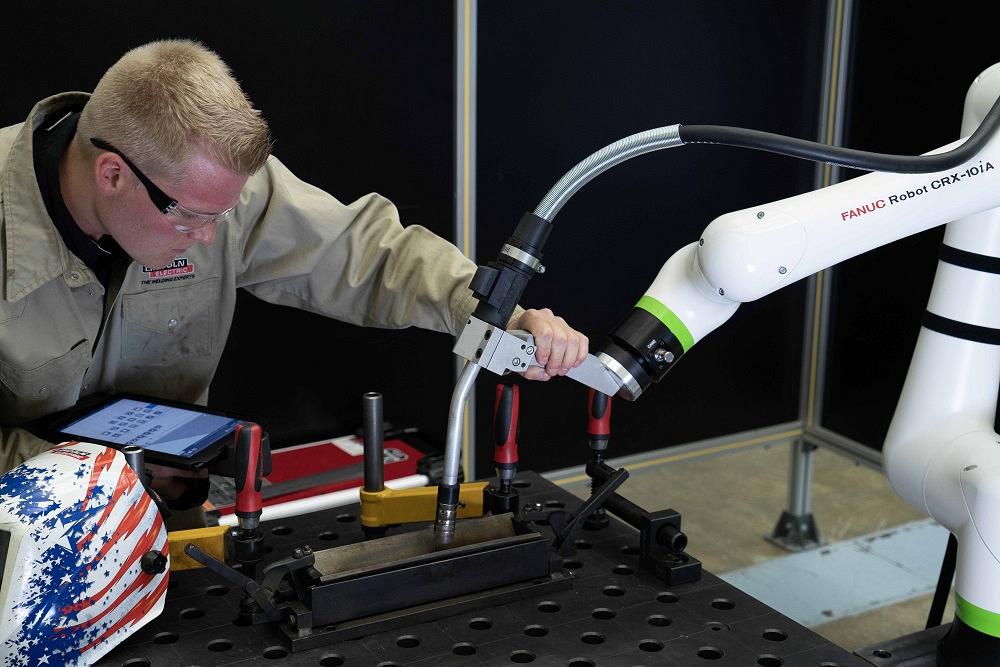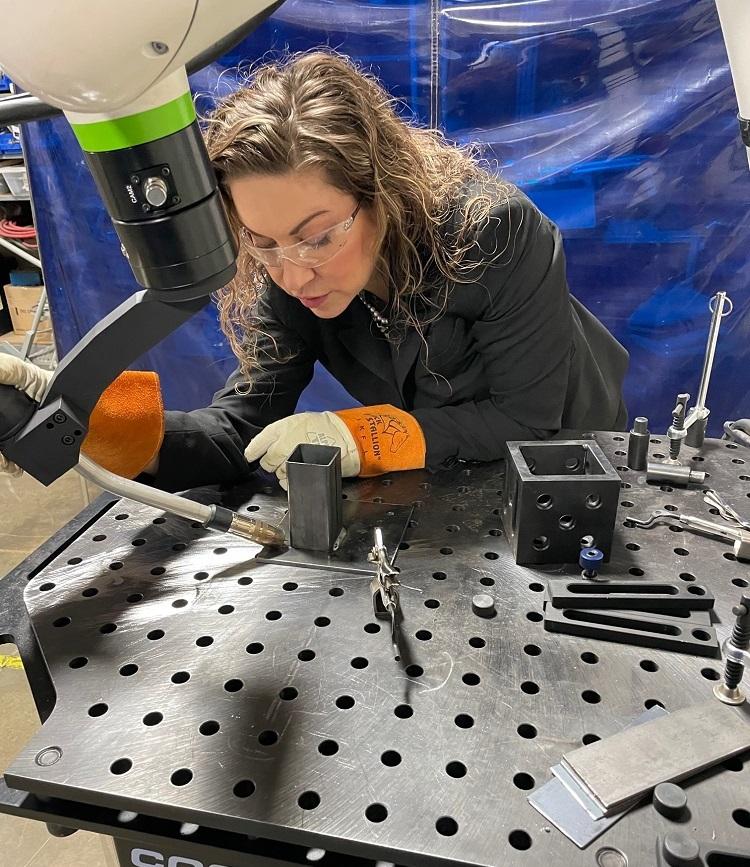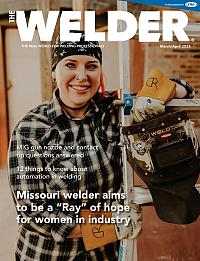Executive Director/CEO
- FMA
- The Fabricator
- FABTECH
- Canadian Metalworking
Categories
- Additive Manufacturing
- Aluminum Welding
- Arc Welding
- Assembly and Joining
- Automation and Robotics
- Bending and Forming
- Consumables
- Cutting and Weld Prep
- Electric Vehicles
- En Español
- Finishing
- Hydroforming
- Laser Cutting
- Laser Welding
- Machining
- Manufacturing Software
- Materials Handling
- Metals/Materials
- Oxyfuel Cutting
- Plasma Cutting
- Power Tools
- Punching and Other Holemaking
- Roll Forming
- Safety
- Sawing
- Shearing
- Shop Management
- Testing and Measuring
- Tube and Pipe Fabrication
- Tube and Pipe Production
- Waterjet Cutting
Industry Directory
Webcasts
Podcasts
FAB 40
Advertise
Subscribe
Account Login
Search
12 key takeaways for welding automation
Considering robots or welding automation? Metal fabrication industry experts weigh in
- By Gary Konarska II
- March 27, 2023
- Article
- Automation and Robotics

Most associate robots and cobots with automation. However, things like tractors, seamers, circle welding systems, positioners, and other similar technologies provide hard automation options when the flexible programming ability of a robot is unavailable.
Editor’s Note: The following is based on “How to Add Automation to Your Business,” a panel discussion hosted by the American Welding Society at FABTECH 2022, Nov. 8-10, 2022, Atlanta.
Automation is at a tipping point in the welding industry due to a convergence of factors. For a deeper dive into how companies could take advantage of automation, the American Welding Society (AWS) broached the subject with four automation industry experts:
- Matheson Zone Vice President Karen Gilgenbach, CWI, CWS, CRAW-T. She is also chair of the AWS D16 Committee on Robotic and Automatic Welding, which authored AWS Standard D16.4, Specification for the Qualification of Robotic Arc Welding Personnel.
- Vectis Automation Chairman and Founder Doug Rhoda.
- FANUC America Corp. Vice President, Automated Systems Group Lou Finazzo.
- Acieta Chairman and CEO Robby Komljenovic. Acieta is a FANUC-authorized system integrator.
I had the pleasure of moderating this panel discussion. To further explore automation, we followed up with these individuals. Following are 12 key takeaways from our conversation.
1. Automation Isn’t Just Robots
Automation can be hard (sometimes called fixed automation or mechanized welding) or flexible (implying the flexibility of programming). Hard automation includes things like tractors, seamers, circle welding systems, positioners, and other similar technologies that lack the flexible programming ability of a robot.
“Tractors are a great example of hard automation,” Gilgenbach said. “If you have a long, straight weld, tractors can reduce variation and the number of starts and stops, which can be a common area for a weld defect to occur.”
Flexible automation can be broken down into pre-engineered robotic cells or custom robotic cells. Pre-engineered cells typically have a great price point and can weld a variety of parts. Custom-engineered cells are usually designed around one part or a one-part family, plus they can offer additional functionality and accommodate larger parts.
“Now there is a third automation category and that’s collaborative robots, or cobots,” said Gilgenbach. A cobot may comprise a welding table or cart to support a robotic arm, and the arm can be hand-guided to create a welding path. A cobot also includes features to program the robot intuitively, as well as the components of the welding or plasma cutting system.
2. Automation Addresses the Skills Gap
“The skills gap—the gap between the tasks we need to accomplish and the skills of the available workforce—creates the need for easy-to-use robot and cobot systems that can be quickly deployed,” said Komljenovic.
Rhoda agreed. “If the cobot operator has any familiarity at all with computers and tablets, that’s helpful; but now, your 59-year-old manual welder can teach the robot by leading the arm through the desired welding path. You don’t need an engineer offline to create the paths.”
3. Robots Create Jobs
The overwhelming consensus was that automation creates career opportunities.

As the welding industry’s use of robots grows, automation experts believe there are a dozen things shops should consider as they ponder automation in welding.Images: American Welding Society
“Robots are critical to the success of any manufacturing facility in the United States. With automation to boost productivity, you can take advantage of more opportunities, and that creates more jobs,” Finazzo said. “When I visit customers, I always ask them two things: ‘What keeps you up at night’ and ‘what's your automation-forward plan?’ There’s no longer a discussion of whether or not companies can continue to do things manually. When that happens, they tend to shrink really quickly. The question is how quickly do you want to adopt automation and what’s your plan?”
“All the skills that our great welders have are transferable to automated welding. They’re just going to be used in a different way,” added Gilgenbach.
4. Consider Speed to Adoption
Don’t let perfect be the enemy of good.
“A pre-engineered robotic cell might meet 90% of their criteria, and 90% is better than zero,” said Finazzo.
Komljenovic agreed, noting that these cell systems are a gateway to growth. “When companies see the success of the first robotic system, when they get answers to unknowns, they’ll figure out very quickly how to grow from there.”
“Cobots lower the barrier for small and medium enterprises,” added Rhoda. “Even very large companies that have high-mix, low-volume applications are great candidates for collaborative robots. The beauty with collaborative robotic welding is that companies can receive their cobot within a few weeks after ordering. When it hits their loading dock, they can cut the shrink wrap in the morning and be production welding by the afternoon.”
5. Start With a Quick Win
Komljenovic noted that there’s a general trend regarding automation, where companies want to take their most complex problem and automate it because they have a hard time with people delivering the required quality.
“Please do not use your most complex part to start your automating journey,” he said. “The right approach is to get a quick win, then make sure you have an automation champion that moves that win forward. That way you’ll create a trust in automation.”
“Look for parts that are repeatable, where you either have a good process or you’re confident you can develop a process,” Gilgenbach added. “Then robots can help you improve productivity.”
Rhoda, who has been working with robots since the 1980s, agreed. “The right place to start is with those simple, mundane subassemblies that are also the most boring for the operator. Shift those tasks to welding automation.”

Shops should identify a point person—an “automation champion”—who will become an expert at programming, operation, maintenance, troubleshooting, and teaching others.
6. Find an Automation Champion
“I want to reinforce the point about having an automation champion,” said Gilgenbach. “Part of our job as automation providers is to help prepare organizations for their new robotic teammate. For a successful implementation, we have to identify a point person that is going to own programming, operation, maintenance, troubleshooting, and teaching others.”
“The key ingredient for a champion is desire,” Rhoda said. “For example, there was a bridge manufacturer in Connecticut [with] an entry-level, 19-year-old grinder intrigued with the cobot on order. He wanted to learn it and be that champion.
“He now has increased his skill level to the point where he’s producing D1.5-certified bridge structural welds with the cobot, which proves that champions can come from anywhere within an organization.”
7. Rethink ROI Metrics
Everyone reports to someone, so being cost conscious and justifying a capital expense is important, but the ROI mindset has changed.
“Quality of the product you’re producing is now more important,” Finazzo said.
As a result of the skilled labor shortage, companies don’t have the extra capacity to account for scrap. With the skyrocketing costs of materials, scrap hurts even more.
“If you’re an automotive supplier, you must have 100% quality,” he continued. “Companies need to assign a value to quality. There’s also a value for lost opportunity.”
Gilgenbach stressed calculating the cost of lost opportunity. “Previously, payback might have been based on the hourly wage or burden rate. Now it’s the jobs that you’re not going to get because you didn’t have the capacity, or your lead time was too long. I think that’s a key change in the way that people are looking at payback for automation.”
“There’s usually a 3-to-1 saving ratio with automatic versus semiautomatic welding, but there’s often the quality savings that are more difficult to recognize,” said Rhoda. “For example, there’s rampant overwelding, such as when the WPS calls for a ¼-in. fillet weld, but the operator makes a 5/16-in. weld. There’s huge savings possible with automation, not only in the material and labor but with eliminating distortion and extra postprocess work.”
8. Don’t Skimp on Tooling
“The cost of tooling is usually the highest barrier to a customer being able to move forward with automation,” said Finazzo.
“Tooling is always more expensive than anyone wants it to be. That’s just the nature of the beast,” added Komljenovic.
Consider tooling and your other needs when you evaluate an automation partner, advised Gilgenbach. “Are you going to buy a cell from one partner and then buy custom tooling somewhere else? Do you already have modular tooling at your shop and you just need the robotic cell? Are you going to want a partner that designs the tooling with you, installs everything, does the programming and the first runoff? I think understanding the level of support that you're going to need is important.”
Rhoda added that part of the appeal of a cobot and outfitted pre-engineered cells with turntables and modular fixturing is they remove a lot of the extra cost and engineering time that was a barrier to automation.
9. Automation Exposes Deficiencies and Bottlenecks
Automation forces improvements in upstream processes.
“CNC-controlled plasma cutting, laser cutting, and press brakes enable automation because they present the robot with consistent parts,” Rhoda said. “Before automating, ask yourself if you have good upstream processes. If not, focus on those first.”
“You can’t spend enough money on upstream processes,” added Finazzo. “Don’t try to bypass those improvements and make up their shortcomings with automation. Look for an automation partner that can help you control tolerances of the parts coming into the cell and you’ll be much more successful.”
Once a company introduces automation, its high precision and repeatability will immediately reveal productivity bottlenecks upstream and downstream of the automated cell.
“One of my favorite books is called ‘The Goal,’” said Rhoda. “It’s now a classic book that’s about the theory of constraints and setting the pace for your factory based on knowing where the bottlenecks are and addressing them.”
10. Vision Systems and Sensing Have Advanced
“Vision and other sensing systems, combined with better decision-making algorithms and machine learning, enable us to deploy robots faster and more intelligently,” Komljenovic said. “Picking applications that were tricky a few years ago are a piece of cake today.”
“2D and 3D vision technology are very easy to adopt now,” added Finazzo. “Because they cost less and are easy to set up, now you can afford to explore and say, ‘I solved this problem and I’m able to reduce cost here, so I can spend more over there.’”
11. Cobots Are Safe
AWS and the Association for Advancing Automation (A3) both have standards for robot and cobot safety.
“To accelerate adoption, you have to ensure that it’s going to be done safely,” said Finazzo. “Even though a cobot has power- and force-limiting measures, there is a thorough risk assessment process. Training is also part of the mitigation tactics.”
“Because there is no fence or light barrier, people wonder if cobots are safe. The answer is yes,” said Komljenovic. “However, you still have a torch at the end of the cobot arm. How safe is a hot torch? Well, it’s about as safe as when you’re welding by hand. That’s why you need to pick an automation partner that helps you understand how to assess risk.”
12. Invest in Education
The experts’ companies invest in programs that reach educational institutions, create mentoring programs, and offer educational opportunities to grow automation skills.
“When you think of return on investment of a corporation, that’s really the return of investment of a country—to give
back and be competitive in manufacturing,” Komljenovic said. “We have a long way to go, but we’re on a good trajectory.”About the Author
Gary Konarska II
8669 NW 36 St. #130
Miami, FL 33166
About the Publication
Related Companies
subscribe now

The Welder, formerly known as Practical Welding Today, is a showcase of the real people who make the products we use and work with every day. This magazine has served the welding community in North America well for more than 20 years.
start your free subscription- Stay connected from anywhere

Easily access valuable industry resources now with full access to the digital edition of The Fabricator.

Easily access valuable industry resources now with full access to the digital edition of The Welder.

Easily access valuable industry resources now with full access to the digital edition of The Tube and Pipe Journal.
- Podcasting
- Podcast:
- The Fabricator Podcast
- Published:
- 04/16/2024
- Running Time:
- 63:29
In this episode of The Fabricator Podcast, Caleb Chamberlain, co-founder and CEO of OSH Cut, discusses his company’s...
- Trending Articles
Sheffield Forgemasters makes global leap in welding technology

ESAB unveils Texas facility renovation

Engine-driven welding machines include integrated air compressors

The impact of sine and square waves in aluminum AC welding, Part I

Compact weld camera monitors TIG, plasma processes

- Industry Events
16th Annual Safety Conference
- April 30 - May 1, 2024
- Elgin,
Pipe and Tube Conference
- May 21 - 22, 2024
- Omaha, NE
World-Class Roll Forming Workshop
- June 5 - 6, 2024
- Louisville, KY
Advanced Laser Application Workshop
- June 25 - 27, 2024
- Novi, MI


























